
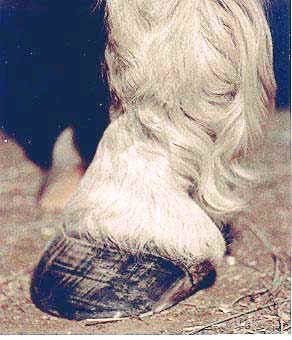
Treating Founder (Chronic Laminitis) without Horseshoes, Section 12
(Version with full-sized photos)
Dr. Strasser explains why shoes make the horse more apparently comfortable, while failing to give much permanent structural improvement. She states that reduced circulation caused by shoes restricting hoof function and circulation also result in a loss of sensitivity. With less sensitivity is an apparent lessening of pain. My experiences would tend to back up her claim that shoes are more palliative than curative. As soon as the shoeing supports are removed, the laminae stretch out again. The lasting solution, in her view, is to restore proper hoof shape, activity and circulation so that the laminae are able to grow in stronger, due to more blood flow. This removes the underlying causes. Stronger new laminae growing down are what will lift the coffin bone back up in position and keep it there.
I sent my October '97 photos to Jaime Jackson, and he told me the heels were still too high. My vet told me the same thing. So on December 21, l997, I lowered the heels, also continuing to rasp back the fronts of the toes to remove dishing and reduce leverage as much as possible. Max was sore for a few days, but soon adjusted. Some of this tranient soreness is caused by the return of circulation. Dr. Strasser describes this as being similar to the pain you feel in your hands when you come in from a bitterly cold day and the circulation begins to return as you warm back up. He immediately lengthened stride, and got more graceful and surefooted. Strangely enough, the hoof angles are still in the fifties. I had earlier been afraid to lower the heels—I figured I would end up with hoof angles in the 40’s. I had also been afraid that lowering the heels would make the hoof wall/pastern axis "broken back." I have since found that lowering the heels changed Max's pastern angles more than the hoof wall/pastern axis or the toe angle. This is because the hoof capsule actually has more give to it than I had realized, and will follow the shape of the bones beneath if there is not a long toe stretching things forward. Lowering the heels put his pasterns at an angle more parallel to his shoulder angle, instead of the upright pastern angles he had with high heels and short toes. This more normal pastern angle lengthened his stride. It also smoothed out the stabbing gait he had from upright pasterns. I have since realized that lowering the heels also shifts more weight further back on the foot, rather than putting most of it on the toe. This reduces pressure on the laminae at the toe, allowing them to grow back in tighter.


Left, October, l997. Max still had high heels and short toes. This created very steep pastern angles. High heels are a recipe for "navicular syndrome" and rotation.
Right, February 1, l998. Lowering heels and letting toes grow 1/4" resulted in a greater change in the pastern angle; hoof wall/pastern axis was unchanged.
Since I lowered the heels, they are getting less under-run. From the first day, it lengthened my horse's stride. Jaime had also shown low heels in his book, but I had been afraid to lower the heels because I was expecting toe angles in the 40's. Actually, angles in the 40's for a horse with rotation are to be expected, but will correct in time as the coffin bone is better suspended and the hoof becomes more compact from front to back.

Max's Heels Getting Less Under-run

Max's left fore, summer of '93, right after resection at OSU.
Note high, under-run heels.
Point of breakover is not backed up enough. Also note quarter crack.
(I believe part of the reason his heartbars were not very successful
was that the toes of his shoes were not backed up enough
and his heels were not lowered enough.)
(Please note: Dr. Strasser is against resections and grooving, and has dealt successfully with founder without resorting to these procedures, which she sees as unnecessary mutilation. She believes that the edge of the resection pinches into the laminae every time the hoof breaks over, impairing circulation. In a later section I will present a case, Yvonne Welz's horse, Inty, where healing was greatly slowed by grooving.)
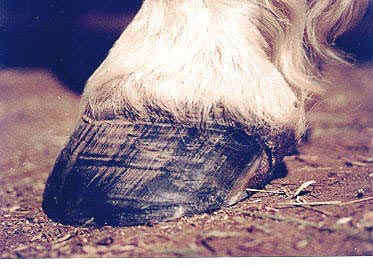
Max's left fore, February 15, l998. Base of support is moving towards the rear
...heels not as under-run. Still have a ways to go yet, though.
Why lowering the heels is important--look at how Babe's high heels, coupled with rotation, result in sole penetration:
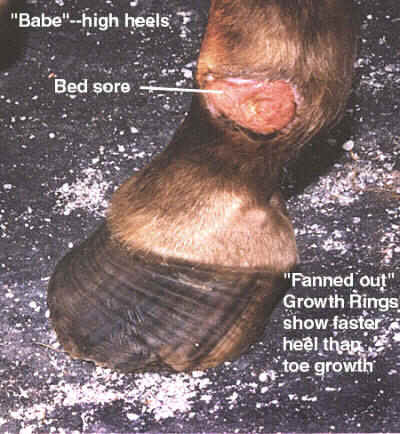


Lowering the heels:
1. Returns the bottom of the coffin bone to a ground parallel position, allowing better hoof mechanism.
2. Puts the frog close enough to the ground to support the coffin bone.
3. Shifts more weight further back on the foot, spreading the weight more evenly over all the laminae, rather than putting more on the toe, where the laminitic connection is the weakest.
4. Rocks the coffin bone back so it is not stabbing straight down through the sole, as it is on the X-ray above. This enables the sole to begin to grow again in the toe area.
5. Reduces pressure on the coronet band in the toe area, especially when coupled with backing up the toe. This enables faster toe growth.
6. Reverses the stretching forward effect of high heels that results in an elongated footprint; lowering the heels encourages the foot to develop a more rounded footprint. To understand this first-hand, put on some high-heeled cowboy boots, and notice how they slide you forward into the toe box.
In addition to the other good effects of lowering Max's heels, this also resulted in the hairlines getting straighter in a few weeks. Dr. Strasser's image on the good effects of lowering the heels, shown at the beginning of this page, mentions that high heels result in crooked hairlines. The coffin bone tip being lower than the palmar processes results in the coronet being pushed high in the quarters by pressure from the palmar processes and lateral cartridges.
Lyle "Bergy" Bergeleen stresses that hairlines will be bulged up and crooked when you are not balancing the hoof correctly. The Dr. Strasser illustration at the beginning of this article shoes how high heels create crooked hairlines. Having the bottom of the coffin bone ground-parallel results in straighter hairlines.
When Max’s heels were too high and under-run, as the photos show, his hairlines, when viewed straight from the side, were a curved line. After lowering the heels, these hairlines rapidly became straighter lines.
Straightening Max's Hairlines
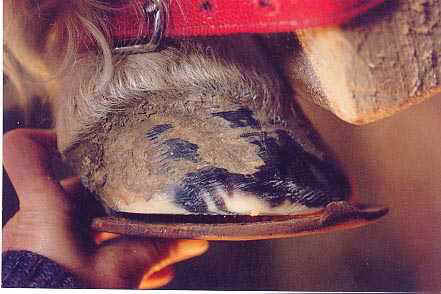
Top-- December 21, l997. Note how crooked Max's hairlines were,
the result of long-term high heels. This was the day I first lowered the heels.
Old '93-4 heartbar held lined up with the apex of the frog
shows how far point of breakover backed up.
Heels STILL too high here, though. Toe backed up too high, too.
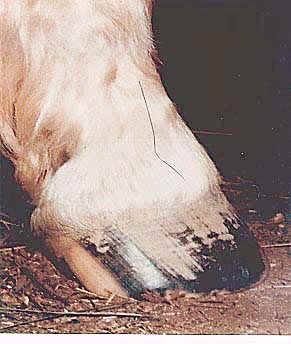
February 1, l998. Hairlines straighter 6 weeks after the heels lowered.
Heels still were not low enough, though.

Another example--my mule's high heels,
shortly after I bought him, resulted in crooked hairlines
and uneven growth rings--see ridged walls.
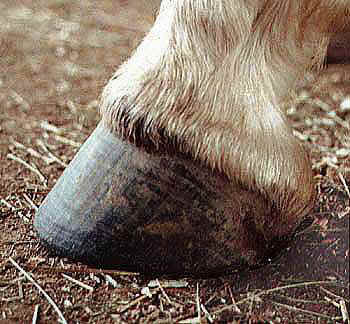
My mule after heels lowered--hairlines straighter
and smoother growth on walls--better circulation
and less hoof wall compression wrinkling.
Another plus to lowering the heels is that it enables enough frog contact and pumping action to spread the heels. You lose a lot of this going from barefoot to shoes, but Lyle "Bergy" Bergeleen alters shoes to make them more elastic to encourage more heel movement and to enable nailing further back without losing as much of this movement.
I do not agree with this idea. These shoes still have some resistance to the heels spreading, and you have additional negatives from steel shoes, many of which are listed in Dr. Strasser's book:
1. Nails are a conduit for infection, and also chill the interior of the hoof in cold weather.
2. Nailing further back too often results in quicking.
3. You cannot reset as often as you can trim a barefoot horse, so an optimum hoof shape cannot be constantly maintained.
4. Steel shoes vibrate when they strike a hard surface. To experience it first-hand, beat an iron rod on concrete for a while--it has a numbing effect. Long term, this can cause tissue damage.
5. Steel shod hooves have less shock absorption than bare hooves having full hoof mechanism, or hooves shod with removable hoof boots.
6. Nail holes break up the walls, just like perforating stamps makes them easier to tear apart.
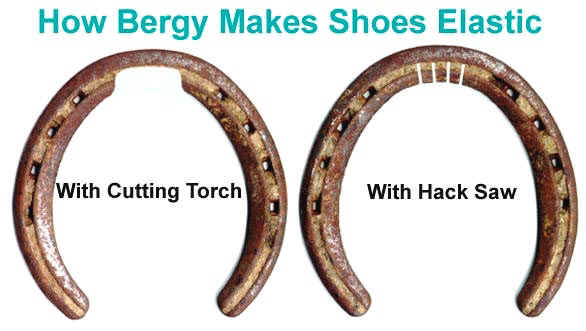
What I had been doing with Max earlier was somewhere in between how much Jaime rasps off, and how much Bergy rasps off to toe. I had been doing a bit of both. I had been rasping out dishing pretty aggressively, but I had also been rolling the edges a good bit, maybe too much. I am more recently doing the Strasser-style back-up, though.
By keeping Max's heels low, the toes rolled and short, and trimming every 3-4 weeks, Max’s white line shrank from 3/4 of an inch wide to 1/4 of an inch wide in 6 months. This seems like really remarkable progress considering that Max was 24 when I started and his white line had been stretched out for several years. However, I did not trim after 12-21-97 for 6 weeks. The toe had grown out enough to put leverage too far out in front, as he was not able to wear his toes down naturally in his soft, muddy pasture, and preserve the mustang roll. With this increased leverage and constant wetness the laminae stretched out to almost 3/8 of an inch. However, another big part of the problem was that he still had high heels. When I redid him, and lowered the heels 1/2", the laminae snapped back to 1/4 of an inch in just days and were closer to 3/16 of an inch. At the present, they are at least this tight, too. However, I would have made much faster progress trimming more often.
Back to home page--Table of Contents
Article in sections with "thumbnail" photos for fastest downloads:
1 9 17
2 10 18
3 11 19
4 12 20
5 13 21
6 14 22
7 15 23
8 16 24
NAVICULAR
Article in sections with full-sized photos for print-outs:
1 9 17
2 10 18
3 11 19
4 12 20
5 13 21
6 14 22
7 15 23
8 16 24
NAVICULAR
To Strasser case studies--thumbnail photos for faster downloads
To Strasser case studies--large photos
Please sign my guest book! Photos of my pets My farm
Share Barefoot success stories on this page
Buy or sell used HORSE BOOTS Natural board Barn Listings
Click here to subscribe to naturalhorsetrim
(I moderate this listserv to weed out "fluff.")
Send Email to Gretchen Fathauer, or call (740) 674-4492
Copyright by Gretchen Fathauer, 2015. All rights reserved.